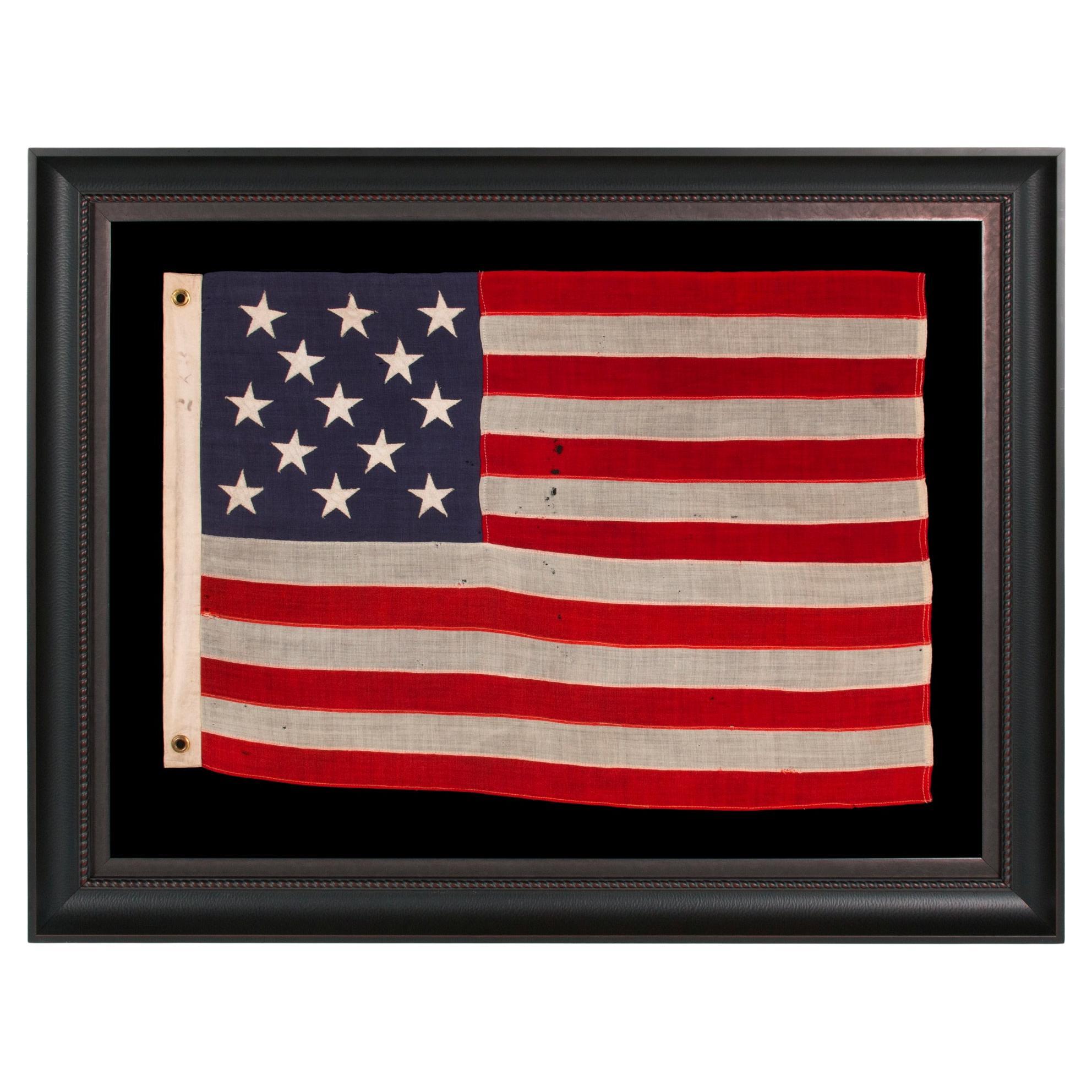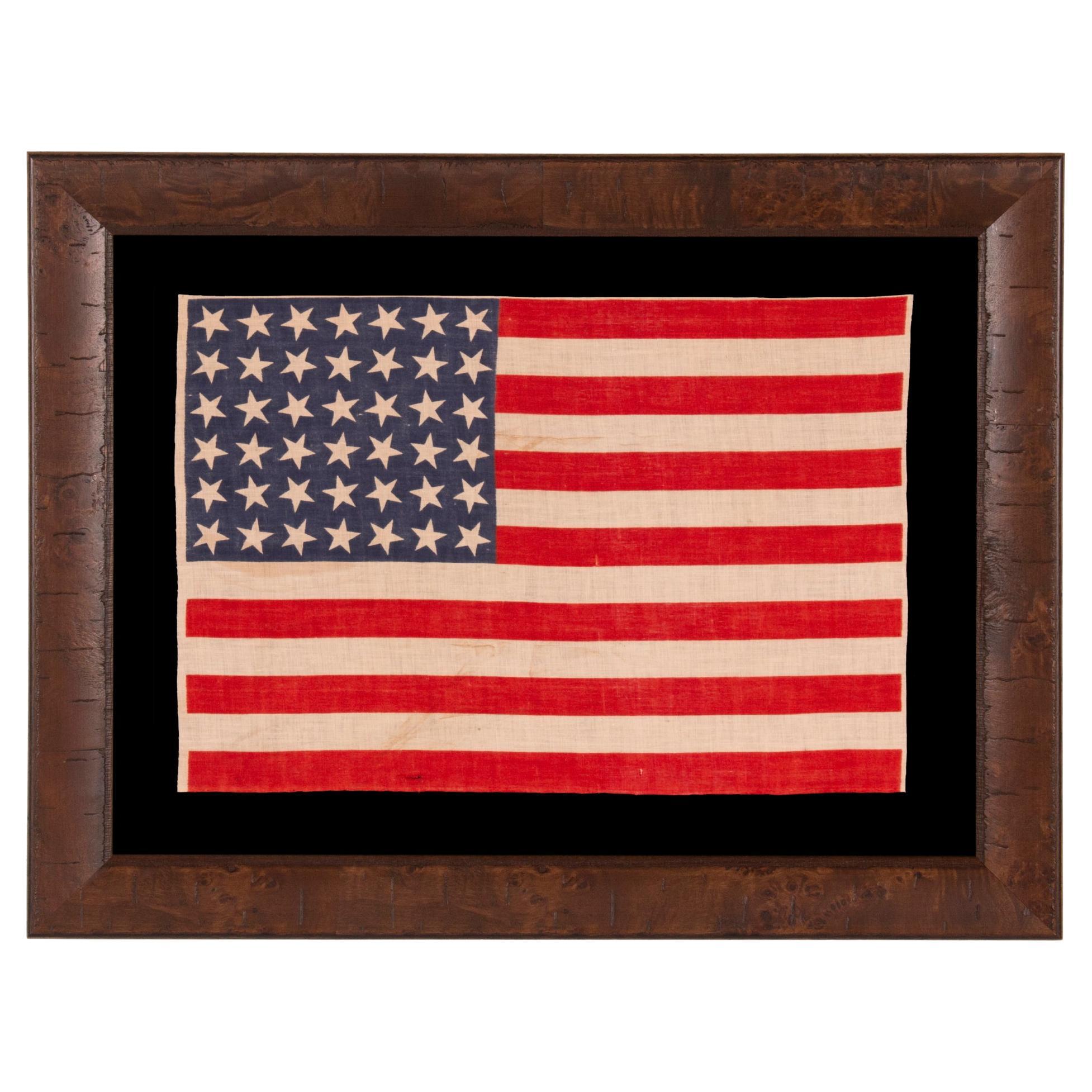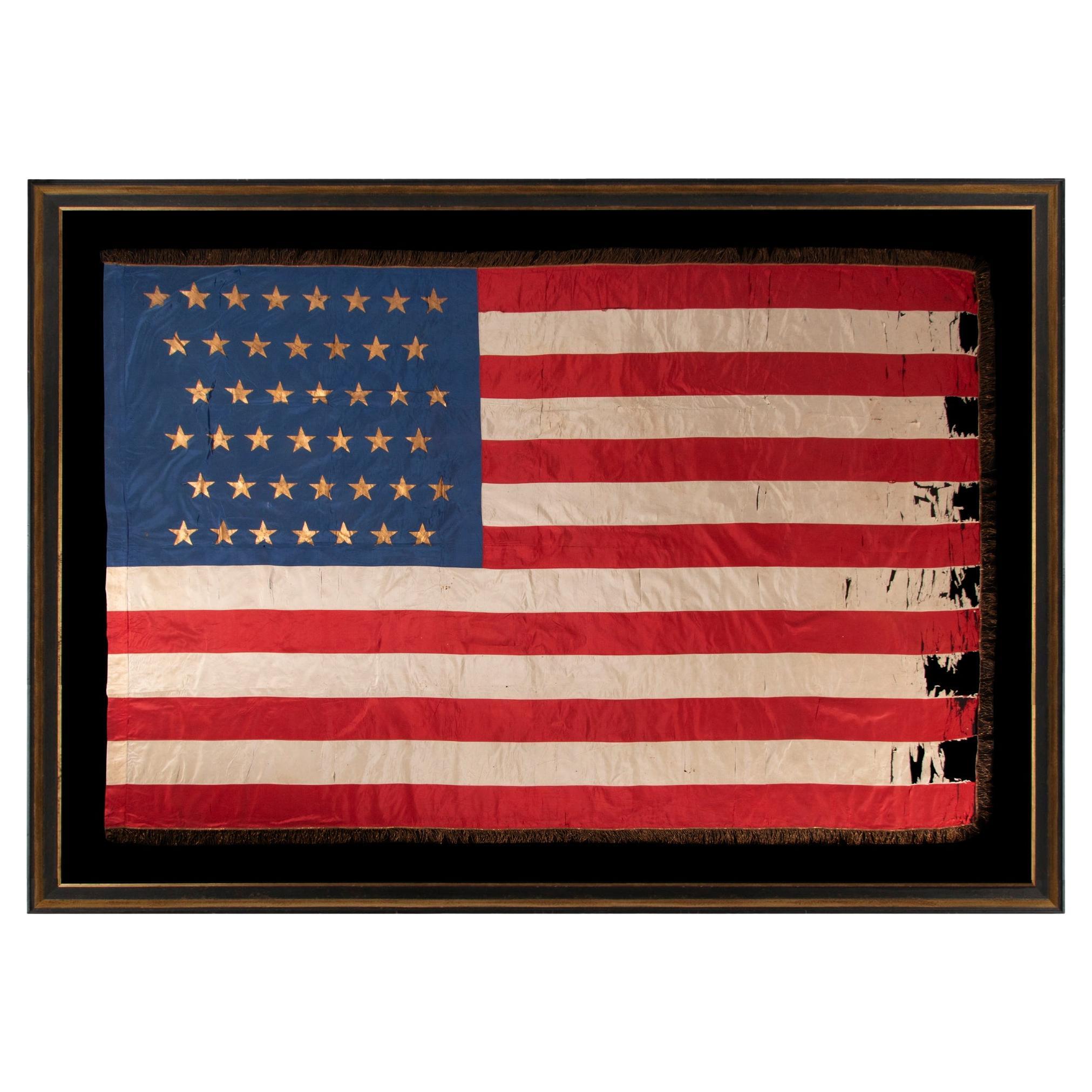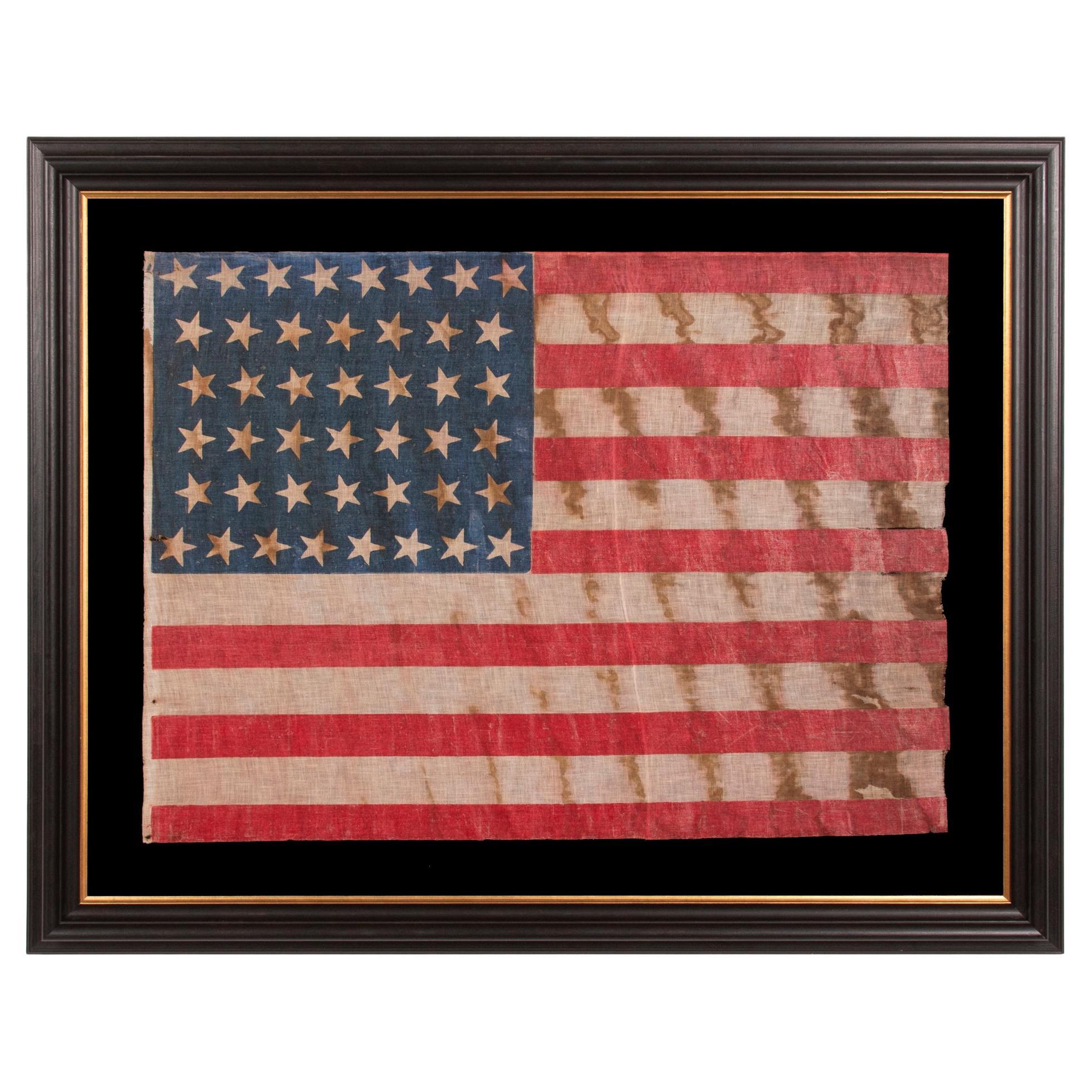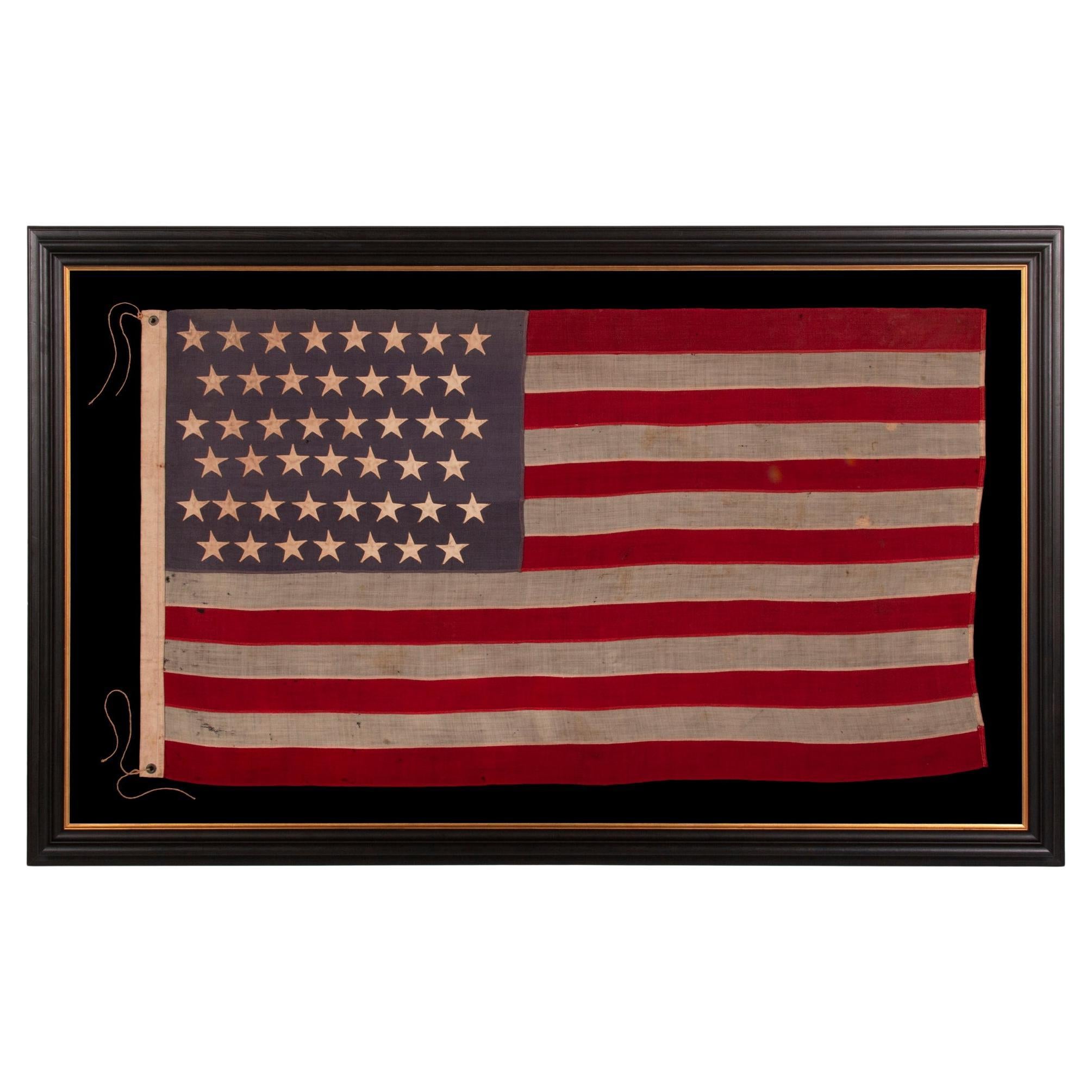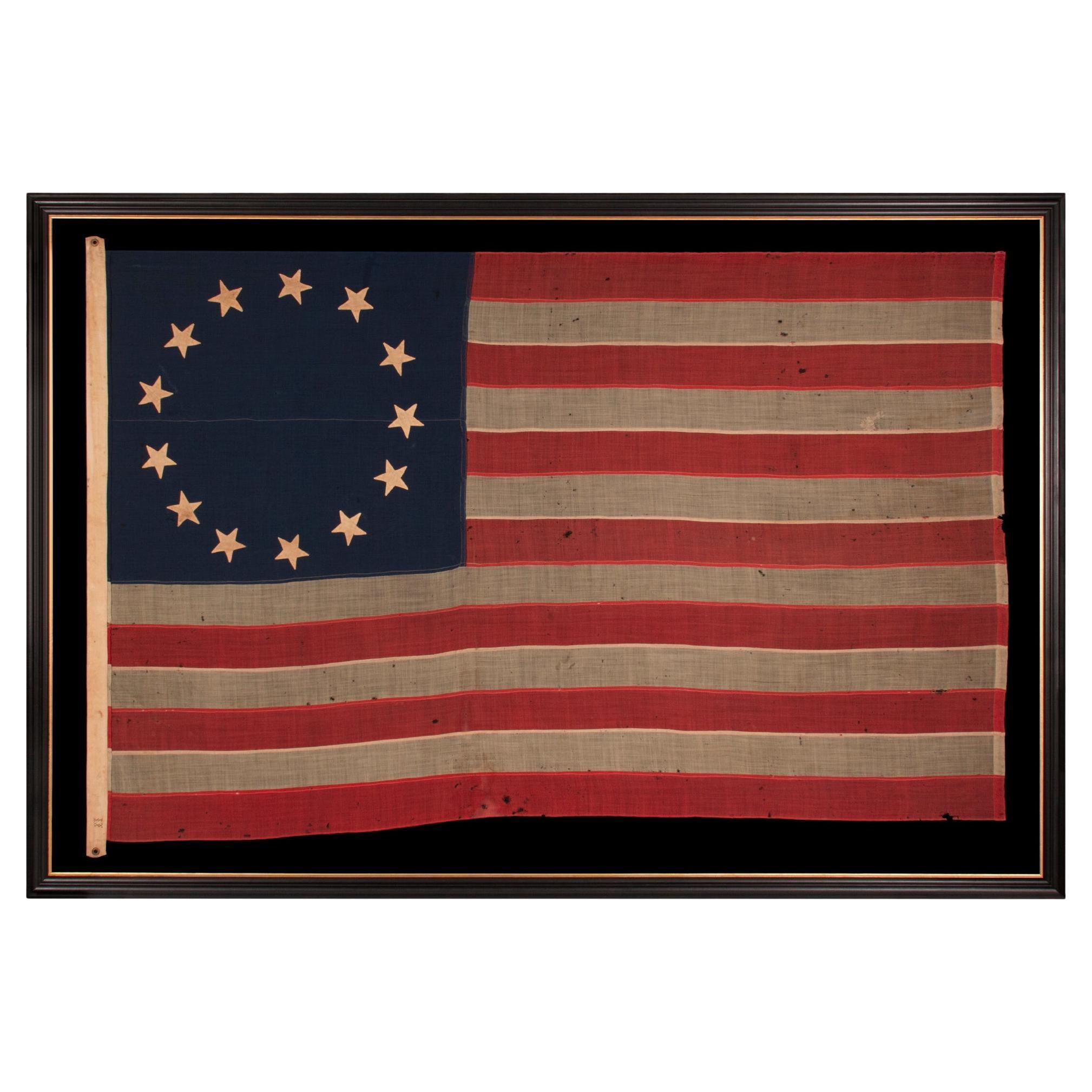Items Similar to 13 Star Antique American Flag , Ca 1890-1899
Want more images or videos?
Request additional images or videos from the seller
1 of 7
13 Star Antique American Flag , Ca 1890-1899
About the Item
13 STARS WITH SHORT, CONICAL ARMS ON A SMALL SCALE, ANTIQUE AMERICAN FLAG MADE DURING THE LAST DECADE F THE 19TH CENTURY; POSSIBLY OF PHILADELPHIA ORIGIN; FORMERLY IN THE COLLECTION OF BOLESLAW & MARIE D'OTRANGE MASTAI, THE FIRST MAJOR COLLECTORS TO PUBLISH A PICTORIAL REFERENCE (KNOPF, NEW YORK, 1973):
13 star flag of the type made from roughly the last decade of the 19th century through the first quarter of the 20th. The stars are arranged in rows of 3-2-3-2-3, which is the most often seen pattern in 13 star flags of the latter 19th and early 20th centuries.
In most cases the 3-2-3-2-3 design can also be viewed as a diamond of stars, with a star in each corner and a star in the very center. It is of interest to note that the 3-2-3-2-3 pattern can also be interpreted as a combination of the crosses of St. Andrew and St. George, which some feel could have been the design of the very first American flag and may identify a link between this star configuration and the British Union Jack. The pattern is often erroneously attributed to New Jersey Senator Francis Hopkinson, a member of the Second Continental Congress and signer of the Declaration of Independence, who is credited with having played the most significant role in the original design of the American national flag. Hopkinson's original drawings for the design of the flag have not survived and his other depictions of 13 star arrangements for other devices are inconsistent.
This particular flag was made during the last decade of the 19th century. The canton and stripes are made of wool bunting that has been pieced with machine stitching. The stars are made of cotton and double-appliquéd (applied to both sides) with a zigzag machine stitch. There is a heavy twill cotton binding along the hoist with two brass grommets.
Note how the stars have profiles, with short, conical arms. Though extremely uncommon, their distinctive bulbous shape is sometimes encountered on commercially-produced flags of this era. I once acquired a flag made by Betsy Ross's great-granddaughter, Sarah M. Wilson, who made little flags with 13 stars in the east Wing of Independence Hall, in Philadelphia, and sold them to visitors. Sarah typically signed her flags along their white binding, accompanied by a date and location. As an alternative to signing the hoist, in this particular instance she elected to instead sign a pressed paper pattern of
a star, used in the making of larger flags. The profile of the pattern was in this design. Among the flags I have owned with stars of this format was one in the 44 star count, stamped along the binding with a maker's mark that read: "J.S. Oberholtzer; 5837 Pulaski Avenue; Germantown [Philadelphia], PA." Due to the above two facts, I suspect that the flags that employed stars in this shape to have been manufactured in the Philadelphia area. I have owned other flags with the same, peculiar stars, sewn in the same manner, but the Oberholtzer example was the only one among them that was signed.
This flag was formerly part of the collection of Boleslaw and Marie D'Otrange Mastai. The Mastai’s held one of the most important private collections of American flags in the country, and their landmark book “The Stars and the Stripes” (Knopf, New York, 1973) was the first major pictorial text on flag collecting. The red-inked Mastai stamp appears three times on the binding, including twice on the obverse and once on the reverse. One of these is accompanied by their numbered identification “No. 239” in green or faded blue pencil. In most instances, modern markings such as these would be considered problematic to a collector. In the case of the Mastai’s, however, their presence is just the opposite, adding substantial interest.
In addition to the above, a previous penciled inscription near the Mastai numbering, on the obverse of the binding, appears to read “Phil.” This is very difficult to discern, though such an inscription would not be surprising, given the probability of origin described above.
Why 13 Stars?
We have made 13 star flags in America from at least 1777, when the first Flag Act was passed, until the present. Since that time, they have been continuously produced for reasons both patriotic and utilitarian. Because this was the original number of stars on the American flag, representing the 13 colonies, it was keenly appropriate for any device made in conjunction with notions of American independence. They were hoisted at patriotic events of all kinds, including Lafayette’s final visit to the U.S. in 1825-1826, the celebration of our nation’s centennial of in 1876, annual observances of Independence Day, and countless others.
From at least 1840 onward, 13 star flags were produced for presidential campaigns, drawing a parallel between the past and present struggles for freedom, and were carried by soldiers during the Mexican and Civil Wars for the same purpose. Throughout history, and even today, they are boldly displayed at every presidential inauguration. As the number of stars grew with the addition of new states, it became more and more difficult to fit their full complement on a small flag. The stars would, by necessity, have to become smaller, which made it more and more difficult to view them from a distance as individual objects. The fear was that too many of them close together would become as one white mass and distort the ability to identify American ships on the open seas. Keeping the count low allowed for better visibility. For this reason the U.S. Navy flew 13 star flags on small boats. Some private ship owners mirrored this practice and flew 13 star flags during the same period as the Navy.
Flag experts disagree about the precisely when the Navy began to revert to 13 stars and other low counts. Some feel that the use of 13 star flags never ceased, which seems to be supported by depictions of American ships in period artwork.
Prior to the 1890’s flags with pieced-and-sewn construction, as opposed to printed parade flags, were typically 8 feet long and larger. A 6-footer was considered small. During the last decade of the 19th century, flag-makers began to produce small flags for the first time in large quantities, namely with dimensions of 2 x 3 feet or 2.5 x 4 feet, like this example. Applying the same logic as the U.S. Navy, they chose the 13 star count rather than the full complement of stars. For all practical purposes, commercial flag-makers simply didn't produce flags in these sizes, with pieced-and-sewn construction, with rare exception, until well into the 20th century.
The use of yachting ensigns with a wreath of 13 stars surrounding a fouled anchor, which allowed pleasure boats to bypass customs between 1848 and 1980, persists today without an official purpose. Because any flag that has previously been official, remains so today, according to the flag acts, 13 star flags both were and currently remain official flags of the United States.
Mounting: The flag has been hand-stitched to 100% natural fabrics throughout for support on every seam and throughout the star field. It was then hand-stitched to a background of 100% cotton twill, black in color, that was washed and treated for colorfastness. The mount was then placed in a black-painted, hand-gilded and distressed Italian molding. The glazing is U.V. protective Plexiglas.
Condition: There is minor mothing and/or minor losses throughout, accompanied by modest to modest of the same in limited areas, the most significant of which are located in the second half of the 3rd, 4th, and 5th white stripes. Fabric of similar coloration was used as the supportive underlay for masking purposes in both the canton and the striped field. Many of my clients prefer early flags to show their age and history of use.
- Dimensions:Height: 42 in (106.68 cm)Width: 61 in (154.94 cm)Depth: 2.5 in (6.35 cm)
- Materials and Techniques:
- Place of Origin:
- Period:
- Date of Manufacture:1890-1899
- Condition:See Item Description.
- Seller Location:York County, PA
- Reference Number:
About the Seller
5.0
Recognized Seller
These prestigious sellers are industry leaders and represent the highest echelon for item quality and design.
Established in 1991
1stDibs seller since 2008
61 sales on 1stDibs
Typical response time: 10 hours
- ShippingRetrieving quote...Ships From: York County, PA
- Return PolicyThis item cannot be returned.
More From This SellerView All
- 13 Star Antique American Flag, ca 1895-1926Located in York County, PA13 STAR ANTIQUE AMERICAN FLAG WITH A 3-2-3-2-3 CONFIGURATION OF STARS ON AN INDIGO CANTON, SQUARISH PROPORTIONS, AND A BEAUTIFUL OVERALL PRESENTATION, MADE circa 1895-1926 This 13 s...Category
Antique Late 19th Century American Political and Patriotic Memorabilia
MaterialsWool
- 42 Star Antique American Parade Flag, Ca 1889-1890Located in York County, PA42 STARS ON AN ANTIQUE AMERICAN FLAG WITH SCATTERED STAR POSITIONING, REFLECTS THE ADDITION OF WASHINGTON STATE, MONTANA, AND THE DAKOTAS, NEVER AN OFFICIAL STAR COUNT, circa 1889-18...Category
Antique Late 19th Century American Political and Patriotic Memorabilia
MaterialsCotton
- 43 Star Antique Silk American Flag, Idaho Statehood, ca 1890Located in York County, PA43 GILT-PAINTED STARS ON A SILK, ANTIQUE AMERICAN FLAG WITH BULLION FRINGE; REFLECTS THE ADDITION OF IDAHO AS THE 43RD STATE ON JULY 3RD, 1890, ONE OF THE RAREST STAR COUNTS AMONG SURVIVING AMERICAN FLAGS OF THE 19TH CENTURY Numerous flags appeared with unofficial star counts in early America, some of them produced by flag-makers in large quantity in anticipation of the addition of more states. Interestingly enough, other flags were officially adopted by the United States Congress, but for all practical purposes were never produced. Among these is the 43 star flag...Category
Antique 1890s American Political and Patriotic Memorabilia
MaterialsSilk
- 44 Star Antiques American Flag, Wyoming Statehood, ca 1890-1896Located in York County, PA44 STAR ANTIQUE AMERICAN FLAG WITH AN HOURGLASS FORMATION OF STARS IN CANTED ROWS, AND AN EXTREMELY INTERESTING PRESENTATION FROM REPEATING SWATHS OF HEAVY OXIDATION, WYOMING STATEHO...Category
Antique Late 19th Century American Political and Patriotic Memorabilia
MaterialsCotton
- 45 Star Antique American Flag, with Staggered Rows, Utah Statehood, ca 1890-1896Located in York County, PA45 STAR ANTIQUE AMERICAN FLAG WITH STAGGERED ROWS OF STARS ON A DUSTY BLUE CANTON; REFLECTS THE PERIOD WHEN UTAH WAS THE MOST RECENT STATE TO JOIN THE UNION, 1890-1896 Utah became t...Category
Antique 1890s American Political and Patriotic Memorabilia
MaterialsWool
- 13 Star Antique American Flag in the Betsy Ross Pattern, ca 1861-1865Located in York County, PA13 star antique American flag in the Betsy Ross pattern, one of just three examples that I have encountered that pre-date the 1890’s; an extraordinary find, civil war period (1861-1865) or just after, extremely large among its counterparts of all periods in this design: Exceptional, early, American national flag, with 13 stars arranged in the circular wreath pattern most often attributed to Betsy Ross. Since there was no official configuration for the stars of the American flag until 1912, when our nation received its 47th and 48th states, the design, before that time, was left to the whims of the maker. This led to an almost unimaginable spectrum of star arrangements on the American flag during the 18th and 19th centuries. Even within the 13 star count, alone, there are at least 80 known patterns—more than the average person would even think possible. 13 star flags have been made throughout American history, from at least June 14th, 1777, when the first Flag Act was passed by Congress, until the present. They have been continuously produced for reasons both patriotic and utilitarian. Because this was the original number of stars on the American flag, representing the 13 colonies, it was appropriate for any device made in conjunction with celebrations or notions of American independence. 13 star flags were thus displayed at patriotic events, including, but certainly not limited to, such occasions as Lafayette’s final visit, in 1825-26, the nation’s centennial in 1876, and longstanding celebrations of Independence Day. From at least 1840 onward, 13 star flags were produced for presidential campaigns, drawing a parallel between the past and present struggles for freedom, and were carried by soldiers, during the Mexican and Civil Wars, for the same purpose. Throughout history, and even today, they are boldly displayed at every presidential inauguration. 13 star flags were flown by American ships both private and federal. The U.S. Navy used 13 stars on the ensigns made for small boats, because they wished the stars to be more easily discernable at a distance. Private ships often copied Navy practice, and when commercial flag makers first began to produce flags with pieced-and-sewn construction, in small sizes, in large quantity, they frequently employed the 13 star count. Flags in the Betsy Ross design are widely admired, due to the longstanding popularity of the Ross family myth. While many Americans learned in grammar school that Betsy Ross made and designed our first flag, and that the stars appeared in a circular fashion, there is, unfortunately, no way to prove the claim. No colonial examples have survived with this pattern of stars. In fact, while arranging the stars in a single circle seems quite logical, among the various choices that might come to mind, early American flags with this star pattern are curiously absent. One of the interesting misconceptions about 13 star flags is that the Betsy Ross pattern, even if not the original design, must have been common in early America. Logic would suggest this, given the frequency with which it appears in modern times, but this isn’t actually the case. In fact, the pattern is seldom encountered anywhere until much later. In more than 30 years of buying and selling early Americana, and over 20 years of extensive focus on the American flag specifically, through aggressively buying, researching, evaluating, restoring, and curating exhibitions, I have thus far encountered just three examples of Betsy Ross pattern flags that I can confidently date prior to the 1890's. No one knows what the first flag looked like. While there is no precise reason that the Betsy Ross design could not have been the first, one of the best arguments against it, is illustrated by the simple fact that so many 13 star flags exist without it. If the Ross configuration was the original, it stands to reason that the pattern would have been reproduced with at least some degree of frequency. Research conducted by the National Museum of American History notes that the story of Betsy Ross making the very first American flag for General George Washington, in the company of George Ross and Robert Morris, entered into American consciousness about the time of the 1876 centennial. The tale was immensely popular among an American public eager for stories about the Revolution and its heroes. The first documentation of it appeared shortly beforehand, in 1870, in a paper written by Betsy’s grandson, William Canby, for the Pennsylvania Historical Society. At the time, Canby made no mention of how the flag was designed, save for the fact that it had 5-pointed stars, per his grandmother’s suggestion. Because no earlier documentation supports the story, most flag scholars feel it was a grand hoax, fabricated by Canby for his own interests. Nothing survives in the collective writings of the three men, for example, nor in records of their words and deeds, which are fairly extensive. As with most things, reality is perhaps somewhere in the middle ground, with some of the details based on fact and some on fiction, made up, misinterpreted, or imagined from family accounts. The first time that a star configuration gets attached to the Ross story appears to have occurred during the last decade of the 19th century. In 1892, Charles Weisgerber painted a nine-by-twelve-foot rendition of the fabled meeting between Betsy and George Washington, in which there is a flag with a circular wreath. Shortly afterwards, in 1898, Betsy’s granddaughter and great-granddaughter began to make flags in the East Wing of Independence Hall in Philadelphia, selling them to tourists while disseminating the family folk tale. In that same year, Weisgerber and a “group of concerned citizens” sought to preserve Betsy’s former Philadelphia residence at 239 Arch Street, where she lived at the time the flag would have been sewed. Weisgerber moved his family into the house and immediately opened to the public the room in which Betsy was said to have worked her magic. Ten-cent memberships were sold to fund renovations and donors received a small calendar, to which a cotton 13 star Betsy Ross pattern parade flag was affixed. The effects of these events caused the Ross legend to stick and the story, with the corresponding flag design, has appeared ever since in more places than one could ever hope to count. The stars of this particular flag are made of cotton, hand-sewn, and double-appliquéd (applied to both sides). The canton and stripes of the flag are made of wool bunting that has been pieced and joined with treadle stitching. There is a sailcloth canvas binding along the hoist, with two brass grommets, one each at the extreme top and bottom. Along this, on the obverse, near the bottom, are two, unusual characters, embroidered with brown thread. These may be letter “I’s,” possibly forming a the Roman Numeral “II.” They are followed by an inscription, in blue ink, that appears to read “A. N. Smith.” The first character is stylized, and may alternatively be a “D,” “H,” or perhaps a “J.” Note how the binding is extended beyond the top and bottom-most points. Though quite unusual, this is sometimes encountered in early examples. The folding of the wool bunting back onto itself, with the binding stitched so that part of the fold is exposed, tends to be an early characteristic. Common in Civil war flags...Category
Antique 1860s American Political and Patriotic Memorabilia
MaterialsCotton
You May Also Like
- Rare Monumental 1890 Antique 42 Star United States of America FlagLocated in Dayton, OHMonumental fifteen foot 42 star American flag, circa 1889-1890. The 42-star flag is rare because only a limited number of 42-star flags were produced after Washington became a state on Nov. 11, 1889. But it takes a more intimate knowledge of flag trivia to know just why it happened this way. White stars are added to the blue field of the star-spangled banner on the Fourth of July after a state is admitted to the union. In the fall of 1889, several western territories became states. Dakota was admitted, and then split into North and South Dakota, on Nov. 2, 1889, which made them state and star numbers 39 and 40. Montana was named the 41st state on Nov. 8, followed by Washington, on Nov. 11. Only a few flag manufacturers began producing 42-star flags before the official addition of the 42nd star on July 4, 1890. Those who tried to jump the gun by being the first to produce an up-to-date flag were surprised when Idaho was admitted to the United States on July 3...Category
Antique 1890s American Classical Historical Memorabilia
MaterialsCotton
- 38-Star Antique American Flag with Unique Canton, circa 1876-1890Located in Colorado Springs, COThis is a striking 38-star American flag. The flag dates to 1876-1890, when Colorado (represented by the large star in the center of the flag’s canton) joined the Union as the 38th s...Category
Antique Late 19th Century American Political and Patriotic Memorabilia
MaterialsMuslin
- 39-Star Antique American Flag with 'Whimsical' Star Pattern, 1889Located in Colorado Springs, COThis is a 39-star unofficial American flag, handmade and printed on cotton. The flag dates to 1889 and has a unique history, thanks to its rare star-count. The flag’s canton is prin...Category
Antique 1880s American Political and Patriotic Memorabilia
MaterialsCotton
- 34-Star Civil War American Flag, Antique Great Star Pattern, circa 1861Located in Colorado Springs, COThe stars of this extremely rare, Civil War-era flag are arranged in what is sometimes called the "Great Flower" pattern, a large star made out of smaller stars -- named as such beca...Category
Antique 1860s American Political and Patriotic Memorabilia
MaterialsLinen
- 46-Star American Flag Printed in Drum Star ConfigurationLocated in Colorado Springs, COThis is an original 46-Star American parade flag, celebrating Oklahoma statehood. Each star on the flag's canton represents a state in the Union at the time. The official flag design would update every July 4th, to include any new states added to the Union in the past year. Oklahoma, the 46th state, entered the Union on November 16, 1907. As such, this 46–star flag was the official flag of the United States from July 4, 1908, until July 4, 1912. The silk flag has a dark blue canton with 46 white printed stars. The stars are printed in an 7-8-8-8-8-7 row configuration, or “Drum design.” The flag design is completed with 13 alternating red and white stripes, each stripe representing one of the original thirteen colonies. The land that comprises Oklahoma today was added to the United States as part of the Louisiana Purchase of 1803. Throughout the 19th century, the U.S. government relocated Indian tribes from the southeastern United States to the area, and by 1900, over 30 Indian tribes had been moved to what was originally called the Indian Territories. At the same time, ranchers in Texas began to move into the area in search of new pasture lands. Although stipulations in the Indian Relocation Act agreed that the land would forever be Indian Territory, the promise of fertile farmland trumped the government’s promise of sovereignty. On April 22, 1889, they opened the land to settlement by homesteaders, creating a land run in which settlers, called “Boomers,” were allowed to cross the Texas or Arkansas border at a particular hour to claim homesteads. Settlers who illegally crossed the border earlier to stake prime land were called “sooners,” which eventually became the state’s nickname. Wagons and the Santa Fe railroad carried cartloads of men and women to blank town sites and building plots, creating ten thousand-people communities in a matter of days. The following year, the region was further divided into Indian Territory and Oklahoma Territory...Category
Vintage 1910s American Political and Patriotic Memorabilia
MaterialsSilk
- 36-Star Printed American Flag, Rare Haloed Star Medallion, Circa 1865Located in Colorado Springs, COThis 36-star flag has stars arranged in a gorgeous and highly desirable medallion pattern. This particular medallion includes a large haloed star in the middle, two rings of stars s...Category
Antique 1860s American Political and Patriotic Memorabilia
MaterialsFabric
